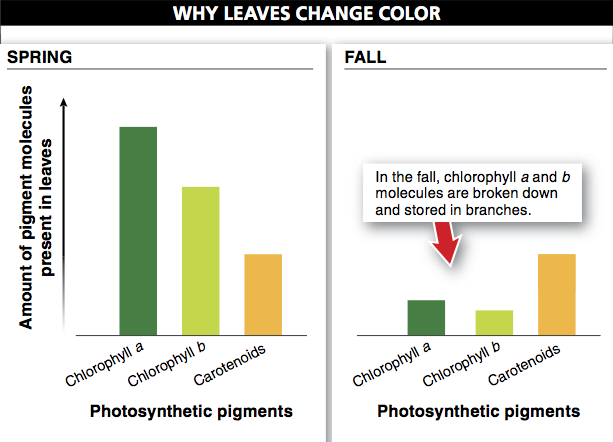
Graphic Content
Chapter 4 Graphic Content
Chapter 4. Chapter 4 Graphic Content
Introduction
Graphic Content
true
true
You must read each slide, and complete the question on the slide, before proceeding to the next one.

Instructions
Review the information provided in the graph to answer each question below.
After submitting your answer, you will be provided feedback to check if your response is correct.
(This activity contains 7 questions.)
1.

1. What are the axes of these two graphs?
The x-axis is the horizontal axis, on which the photosynthetic pigments are listed. The y-axis is the vertical axis, which shows the height of each bar and is a measure of the amount of the pigment molecule (for each pigment on the x-axis) present in leaves.
2.

2. What variable(s) is presented? How was it measured? What do the colors represent?
The independent variable is the time at which the researcher measured the amounts of photosynthetic pigments in leaves. The researcher controlled this, by deciding when to make the measurements. The dependent variable is the measure of the amount of the pigment molecule (for each pigment on the x-axis) present in leaves. Based on the information in the graph, you cannot determine how the amounts of pigment molecules were measured. Presumably, this was done by some sort of biochemical assay, but you cannot be sure. The colors of the bars give an extra bit of information, showing the color of light reflected by each of the pigments.
3.

3. Do you know the source of the information in the graph? Does that matter? Why or why not?
The source of the data is not given. In this case, this probably does not reduce the value of the information in the graph by much. It can be important to know the source of a graph’s data if the graph is being used to persuade the reader to believe something controversial, or is being used to advance some sort of political or social agenda. In the figure here, it’s hard to imagine why the data would not be reliable or trustworthy. However, it would be useful to know whether the researcher had the technical training and skills to carry out the data collection appropriately.
4.

4. Why are there two graphs? What is the difference between them?
The two graphs are measures of the amounts of pigment, for three different pigments, in spring versus fall. This allows us to evaluate differences in the photosynthetic pigments present in leaves at two different times of year, when the leaves appear green and when they have the red, orange, and yellow colors characteristic of fall foliage. We can see that the amount of yellow-reflecting carotenoids is the same in spring as in fall, but the green-reflecting chlorophylls a and b are present in much smaller amounts in fall than in spring.
5.

5. What can you conclude from this figure?
The colors of leaves in the fall are a consequence of reduced amounts of chlorophylls a and b in the leaves, which reduces the green reflectance, but the amounts of yellow-reflecting pigments are unchanged.
6.

6. What additional information would make this figure more helpful? Why?
First, in the fall, leaves have many colors, including yellow. It would be helpful to see measures of the amounts of other photosynthetic pigments in leaves in the fall and spring. Which ones are responsible for the other colors? Second, as with any graph, a standard deviation or standard error bar for each bar in the graph would be useful. This would indicate how much leaves vary in the amounts of each pigment they contain. Is it a lot? Or are the amounts relatively constant from leaf to leaf? From this figure, we don’t know. Third, it might also be interesting to see the same pair of plots for several different species, including some trees whose leaves change color in the fall and other trees whose leaves do not change color.
7.

7. Do the data report experimental results? Is there a control group? An experimental group?
These graphs show experimental results, namely, that the relative amounts of photosynthetic pigments differ at the two time periods measured. There are no control and experimental variables, however. Rather, there are just measures of the different pigments at different times.
Activity results are being submitted...